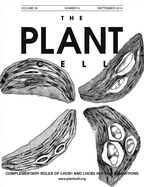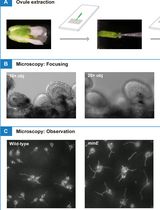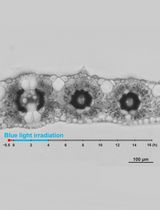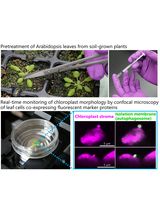- EN - English
- CN - 中文
Quantification of the Volume and Surface Area of Symbiosomes and Vacuoles of Infected Cells in Root Nodules of Medicago truncatula
根瘤感染的蒺藜苜蓿细胞中共生体和液泡的体积和表面积的定量测定
发布: 2015年12月05日第5卷第23期 DOI: 10.21769/BioProtoc.1665 浏览次数: 11236
评审: Arsalan DaudiRenate WeizbauerAnonymous reviewer(s)
Abstract
Legumes are able to form endosymbiotic interactions with nitrogen-fixing rhizobia. Endosymbiosis takes shape in formation of a symbiotic organ, the root nodule. Medicago truncatula (M. truncatula) nodules contain several zones representing subsequent stages of development. The apical part of the nodule consists of the meristem and the infection zone. At this site, bacteria are released into the host cell from infection threads. Upon release, bacteria are surrounded by a host cell-derived membrane to form symbiosomes. After release, rhizobia grow, divide, and gradually colonize the entire host cell of the fixation zone of root nodules. Therefore, mature infected cells contain thousands of symbiosomes, which remain as individual units among other organelles. Visualization of the organization and dynamics of the symbiosomes as well as other organelles in infected cells of nodules is essential to understand mechanisms regulating the development of endosymbiosis between plants and rhizobia. To examine this highly dynamic developmental process, we designed a useful imaging technique that is based on confocal scanning microscopy combined with different fluorescent dyes and GFP-tagged proteins (Gavrin et al., 2014). Here, we describe a protocol for microscopic observation, 3D rendering, and volume/area measurements of symbiosomes and other organelles in infected cells of M. truncatula root nodules. This protocol can be applied for monitoring the development of different host-microbe interactions whether symbiotic or pathogenic.
Keywords: Symbiosis (公司治理)Materials and Reagents
- Microscope cover glasses
- Microscope slides
- Perlite (Maasmond-Westland, The Netherlands)
- 7 days old seedlings of M. truncatula (seeds can be obtained at The Samuel Roberts Noble Foundation)
- Agrobacterium rhizogenes MSU440 strains (can be obtained at the Laboratory of Molecular Biology, Wageningen University, The Netherlands) containing pUB:GFP-MtVTI11 or pLB:GFP-MtVTI11 binary vector (see Note 1)
- Sinorhizobium meliloti 2011 (see Note 2)
- 0.1 M sodium phosphate (Sigma-Aldrich, catalog numbers: S8282 and S7907 ) buffer (pH 7.2) with 3% sucrose (Sigma-Aldrich, catalog number: S7903). For preparation protocol see Sambrook and Russell (2001)
Note: Sodium phosphate monobasic (Sigma-Aldrich, catalog number: S8282) and Sodium phosphate dibasic (Sigma-Aldrich, catalog number: S7907) - 10 μg/ml Propidium iodide (store at 4 °C) (Sigma-Aldrich, catalog number: P4170 )
- 1% paraformaldehyde (Electron Microscopy Sciences, catalog number: 15700 )
- 0.75% glutaraldehyde (Electron Microscopy Sciences, catalog number: 16000 )
- 50 mM phosphate buffer (Sambrook and Russell, 2001)
- Fixative (see Recipes)
Equipment
- Fluorescence stereomicroscope (Leica Microsystems, model: MZFLIII )
- Confocal laser scanning microscope with digital camera (ZEISS, model: Axiovert 100M )
- Razor blades
- Fine tweezers (Structure Probe, Dumont, model: 0T05B-XD )
Software
- IMARIS software (Bitplane) with modules for data management, visualization, 3D rendering and analysis
- Zeiss LSM Image Browser
Procedure
文章信息
版权信息
© 2015 The Authors; exclusive licensee Bio-protocol LLC.
如何引用
Gavrin, A. and Fedorova, E. E. (2015). Quantification of the Volume and Surface Area of Symbiosomes and Vacuoles of Infected Cells in Root Nodules of Medicago truncatula. Bio-protocol 5(23): e1665. DOI: 10.21769/BioProtoc.1665.
分类
植物科学 > 植物生理学 > 胞内共生
植物科学 > 植物细胞生物学 > 细胞成像
细胞生物学 > 细胞成像 > 共聚焦显微镜
您对这篇实验方法有问题吗?
在此处发布您的问题,我们将邀请本文作者来回答。同时,我们会将您的问题发布到Bio-protocol Exchange,以便寻求社区成员的帮助。
Share
Bluesky
X
Copy link













